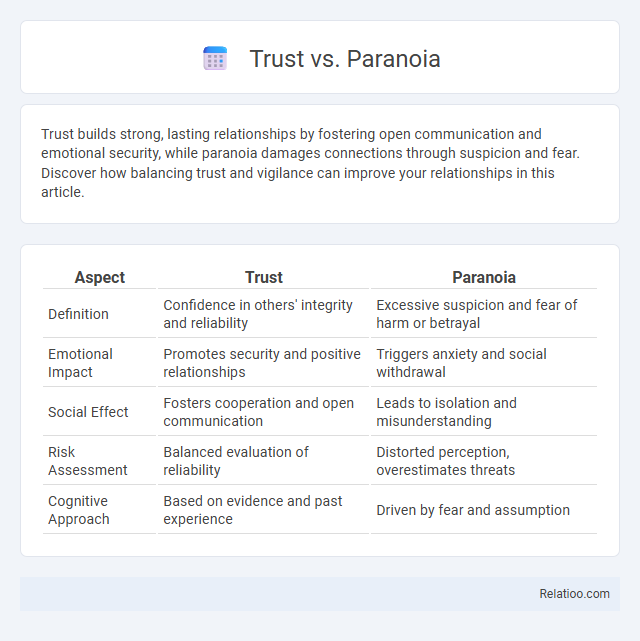Trust builds strong, lasting relationships by fostering open communication and emotional security, while paranoia damages connections through suspicion and fear. Discover how balancing trust and vigilance can improve your relationships in this article.
Table of Comparison
| Aspect | Trust | Paranoia |
|---|---|---|
| Definition | Confidence in others' integrity and reliability | Excessive suspicion and fear of harm or betrayal |
| Emotional Impact | Promotes security and positive relationships | Triggers anxiety and social withdrawal |
| Social Effect | Fosters cooperation and open communication | Leads to isolation and misunderstanding |
| Risk Assessment | Balanced evaluation of reliability | Distorted perception, overestimates threats |
| Cognitive Approach | Based on evidence and past experience | Driven by fear and assumption |
Understanding Trust: Definition and Importance
Understanding trust involves recognizing it as a fundamental psychological and social construct essential for effective relationships, decision-making, and collaboration. Trust enables you to rely on others' intentions and actions, fostering security and cooperation, while its absence often leads to paranoia characterized by mistrust and fear. Establishing trust enhances emotional well-being, reduces uncertainty, and supports healthy interactions both personally and professionally.
The Roots of Paranoia in Human Behavior
Paranoia stems from deep-seated psychological mechanisms rooted in survival instincts and social interactions that historically heightened caution against threats. Your brain's tendency to detect threats, even in ambiguous situations, can amplify mistrust and fear, often misinterpreting neutral or benign cues as harmful. Understanding these roots helps distinguish adaptive vigilance from maladaptive paranoia, essential for maintaining trust in relationships and environments.
Psychological Mechanisms Behind Trust
The psychological mechanisms behind trust involve complex cognitive processes such as evaluating past experiences, assessing the reliability of others, and managing risks in social interactions. Your brain activates regions like the amygdala and prefrontal cortex to balance emotions and rational decision-making, facilitating trust or distrust based on perceived safety. Understanding these mechanisms helps distinguish healthy trust from paranoia, where irrational fear overrides logical assessment.
How Paranoia Affects Relationships
Paranoia often distorts your perception of others' intentions, leading to mistrust and constant suspicion in relationships. This heightened sense of fear can cause frequent misunderstandings, communication breakdowns, and emotional distance between partners or friends. Over time, such patterns erode trust, making it difficult to maintain healthy and supportive connections.
Signs You’re Leaning Toward Trust or Paranoia
Signs you're leaning toward trust include open communication, consistent reliability, and willingness to share personal thoughts without fear. Indicators of paranoia involve constant suspicion, overanalyzing others' intentions, and feeling unsafe without clear evidence. Your mindset shifts depending on how confidently you interpret others' actions and your ability to manage uncertainty.
The Role of Past Experiences in Shaping Perceptions
Past experiences significantly influence your ability to trust or foster paranoia, as repeated negative encounters can condition your brain to expect harm, thereby altering perception patterns. Trust builds when positive experiences reinforce a sense of safety and reliability, while unresolved trauma or betrayal can heighten vigilance and suspicion. Understanding this dynamic helps in recognizing how memories shape present interactions and emotional responses.
Building Trust: Practical Strategies
Building trust requires consistent communication, transparency, and reliability to counteract the negative effects of paranoia. You can foster trust by setting clear expectations, actively listening, and demonstrating empathy in interactions. Practical strategies include regular feedback, acknowledging concerns without judgment, and maintaining confidentiality to create a secure environment.
Overcoming Paranoia: Steps Toward Security
Overcoming paranoia involves recognizing irrational fears and replacing them with evidence-based thinking to foster a sense of safety. Building trust through consistent and transparent communication strengthens relationships and reduces the impulse to suspect harmful intentions. Developing self-awareness and seeking professional support, such as cognitive-behavioral therapy, are crucial steps toward achieving emotional security and mental well-being.
Trust vs Paranoia in the Digital Age
Trust in the digital age hinges on secure data encryption, transparent privacy policies, and reliable authentication methods to protect users against cyber threats. Paranoia arises when individuals encounter frequent data breaches, misinformation, or invasive surveillance, leading to skepticism of digital platforms and reluctance to share personal information. Balancing trust with cautious vigilance requires continuous advancements in cybersecurity and fostering digital literacy to empower users in managing their online interactions safely.
Choosing Balance: Navigating Between Trust and Paranoia
Navigating between trust and paranoia requires a delicate balance where informed caution guides your decisions without tipping into excessive suspicion that hinders relationships. Establishing trust involves assessing evidence, recognizing credible patterns, and setting boundaries that protect your well-being while maintaining openness. Developing emotional intelligence and critical thinking skills enhances your ability to discern trustworthy individuals, fostering healthier interactions and reducing the detrimental effects of paranoia.

Infographic: Trust vs Paranoia
 relatioo.com
relatioo.com